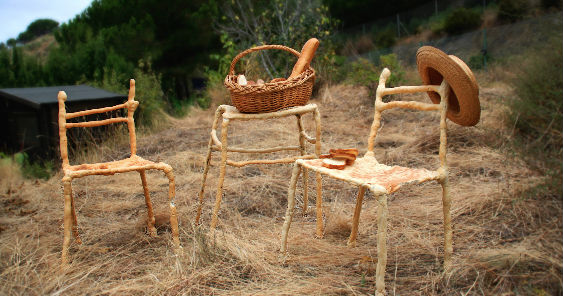Food, design and the art of presentation.
by Anson Yu
Whenever we discuss the relationship between food and design, it’s often limited to the area of presentation. But for Spaniards, the link between food and design goes much deeper. Consider the Jamora stand: more than just an implement to display a gorgeous leg of ham, it’s also designed to give the ham stability when the chef carves paper-thin slices. Another food and design collaboration: Chupa Chups lollipops, whose wrapping was designed by Salvador Dali.
You can learn more about how Spain mixes up the world of design and cooking at the ongoing exhibit, “Tapas: Spanish design for food,” on show at the Metropolitan Museum of Manila until June 16, 2016. The traveling exhibit has been crisscrossing the globe since 2013. Organized by the Accion Cultural Espanola (AC/E), it features more than 200 objects, videos and photographs. They range from traditional wineskins known as bota de vino, to a 3-D printer capable of printing out organically-shaped edible plates.
Juli Capella, tasked by the AC/E to curate the exhibit, is a designer and architect who is no stranger when it comes to combining food and design, as he has collaborated with Chef Jose Andres on a number of projects. When asked in an interview as to why he thinks the Spaniards connect food and design is that he believes they love to play with its food not just eat it. “Because we are a poor country, people celebrate the food as a special party.”
Divided into three sections, the exhibit looks at the kitchen, the table and food design. But regardless of sectioning, a standout element of the exhibit was the element of whimsy and playfulness in Spanish design, particularly in its more recent examples. A fine specimen would be the half-spoon and half-clothespin creation by industrial designer Luki Huber, which allows a sprig of herb or leaf to be attached to the spoon to so that it can add an extra smell dimension to the dish.
This playful approach to food and design can be credited largely to Chef Ferran Adria of El Bulli fame. Having once said that cooking for him is designing food, he blended together the world of food and design when he created new tools to help define his style of molecular gastronomy. Adria invented the Spherification kit that can create flavored faux caviars, and collaborated with other designers such as Huber to come up with the design for the Spaghetto kit which creates strands of jelly spaghetti.
Interestingly enough, Chef Adria doesn’t mind if other people copy his work, in fact he says it gives him pleasure. “If someone is being copied it is because they are really imaginative. They only copy creative people and our job is to be creative.”
A must-see not only for chefs but also for designers, artists and engineers as well, the exhibit should encourage us to consider looking at art and science to help push the boundaries of Filipino cuisine.
This article was first published in the July-August 2016 issue of adobo magazine.








